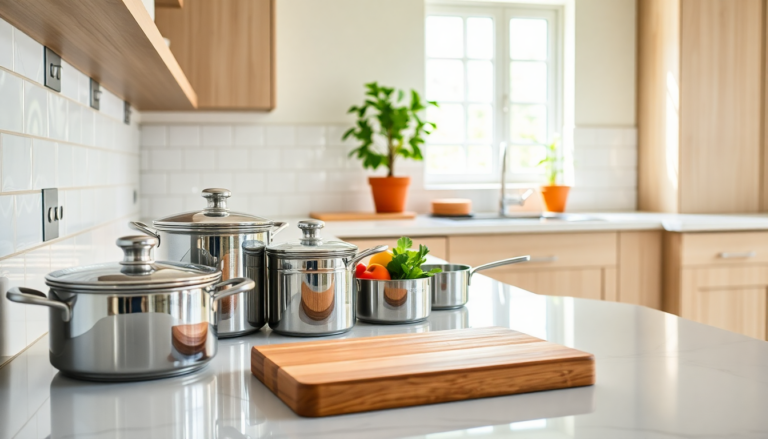Argomenti trattati
Creating a kitchen that strikes the perfect balance between functionality and style is truly an art form. It’s not just a space for cooking; it’s often dubbed the heart of the home—a place where culinary masterpieces are born and cherished memories are forged over shared meals. In today’s fast-paced world, your kitchen design needs to meet the demands of modern living while also reflecting your personal style. So, how can you achieve this delicate balance? Let’s dive into some strategic planning and attention to detail that can transform your kitchen into a dream space.
What’s Hot in Kitchen Design?
The world of kitchen design is always changing, and new trends are cropping up that prioritize both efficiency and aesthetics. One standout trend is the open-concept kitchen, which seamlessly melds with dining and living areas. This design choice promotes fluid movement and interaction, making it a breeze for families and guests to gather and enjoy each other’s company. Could this be the perfect solution for your home?
Another exciting trend focuses on sustainability. More homeowners are opting for eco-friendly materials and energy-efficient appliances, proving that you can have high performance without harming the planet. Stylish finishes and fixtures that are both elegant and durable are on the rise, creating spaces that are as functional as they are beautiful.
And let’s not forget about technology! From smart refrigerators that keep track of your inventory to touchless faucets that make cooking a breeze, integrating tech into your kitchen can elevate the experience. As we look ahead, kitchens are evolving into not just functional cooking areas, but also hubs of innovation and comfort.
Diving Into Data: Analysis and Performance Metrics
When it comes to planning your kitchen renovation, relying on data is key. Analyzing how you currently use your kitchen can unveil insights that guide your design choices. For example, understanding when you cook most often and your meal prep habits can help you position appliances and workstations for optimal workflow. Isn’t it fascinating how a little data can lead to big improvements?
Performance metrics, such as return on investment (ROI) for different kitchen features, are also crucial. How will your renovations affect your property value and everyday life? Consider this: a well-designed kitchen island doesn’t just improve functionality; it can also serve as the centerpiece for gatherings, enhancing your home’s overall appeal.
Furthermore, gathering feedback through surveys after your renovation can provide invaluable insights for future designs. By leveraging data, you can make sure your investment results in a space that meets your culinary needs and fits your lifestyle.
Case Study: A Kitchen Designed for Functionality
Let’s take a look at a real-life example. A couple approached their kitchen remodel with a clear vision: create a space that’s perfect for both cooking and entertaining. They chose a U-shaped layout that maximized counter space while ensuring a smooth flow between the refrigerator, sink, and stove—a classic triangular setup known for its efficiency.
Investing in high-quality materials was a priority for them. They selected durable quartz countertops and custom cabinetry that offered ample storage while still looking stylish. They even added a large island that doubled as a prep area and a casual dining spot. This design transformation not only boosted functionality but also fostered an inviting atmosphere for guests.
After the renovation, performance metrics revealed a remarkable increase in the couple’s cooking frequency. They found their new space more enjoyable and accessible. Plus, its aesthetic charm contributed to a higher resale value for their home, underscoring the importance of thoughtful design.
Practical Implementation Tactics
So, how do you implement an effective kitchen design? Start by assessing your current space. What works? What doesn’t? It’s essential to consider your cooking habits and lifestyle when outlining your needs. What will make your time in the kitchen more enjoyable?
Next, it’s time to partner with a professional designer who can help bring your vision to life. An experienced designer will know the ins and outs of kitchen layouts, including how to maximize natural light and incorporate ergonomic principles for enhanced usability.
When it comes to materials and appliances, remember: quality over quantity. Focus on essential elements that can withstand daily use while complementing your kitchen’s style. Plus, energy-efficient appliances are a win-win, saving you money on utility bills while aligning with modern sustainability trends.
Lastly, keep an open mind during the implementation process. Unexpected challenges might pop up, but being adaptable can lead to an even better final product. The goal here is to create a kitchen that not only looks stunning but also enhances your culinary experiences!
Key Performance Indicators to Monitor
Once your kitchen renovation is wrapped up, it’s time to establish key performance indicators (KPIs) to measure your design’s success. Start by tracking how often you use your new kitchen. Are you cooking more frequently? This metric can help you determine if the space meets your functional needs.
User satisfaction is another crucial indicator. Consider conducting informal surveys with family and friends to gather their thoughts on the kitchen’s layout, aesthetics, and overall functionality. Are there features they love, or areas they think could use some improvement?
Moreover, keep an eye on any shifts in your cooking habits. Have you started experimenting with new recipes or hosting more dinner parties? These changes can signal that your kitchen is successfully enhancing your lifestyle.
Finally, don’t forget to assess the financial impact of your renovation. Monitor property value trends in your area to see if your investment has paid off. By analyzing these KPIs, you can ensure that your kitchen remains a valuable asset for years to come.

